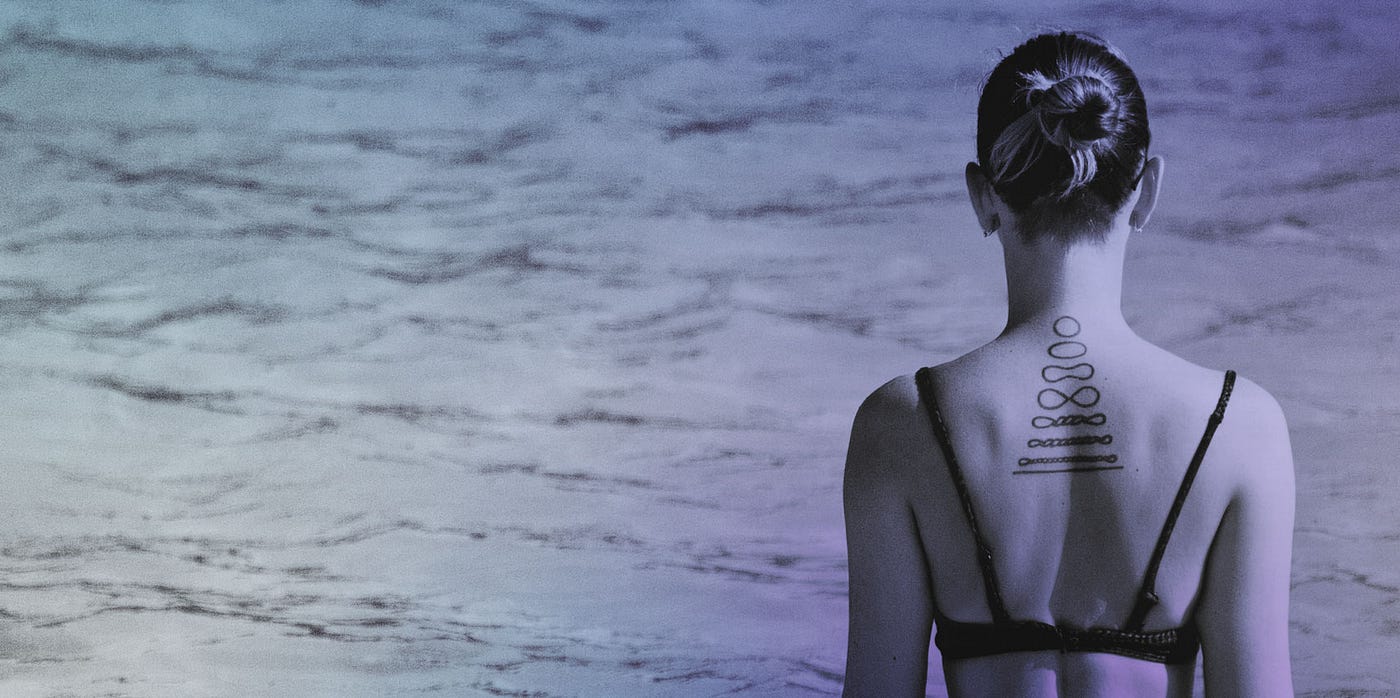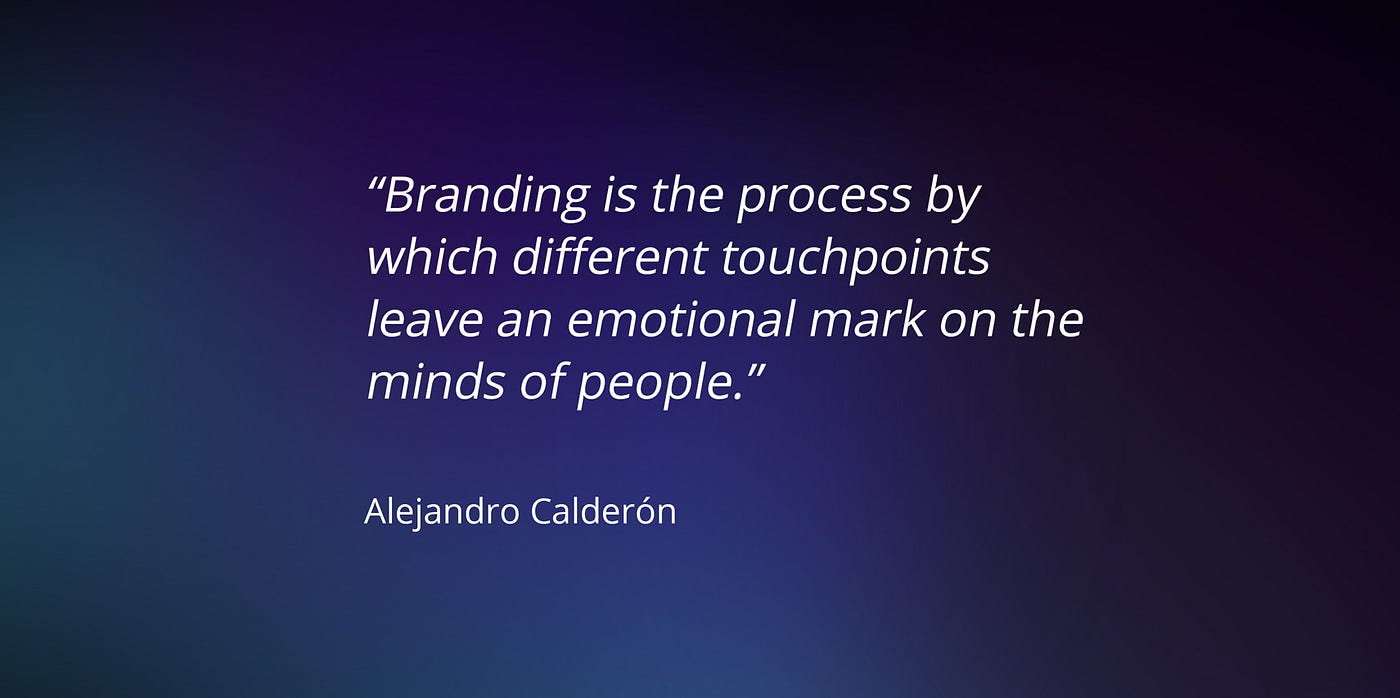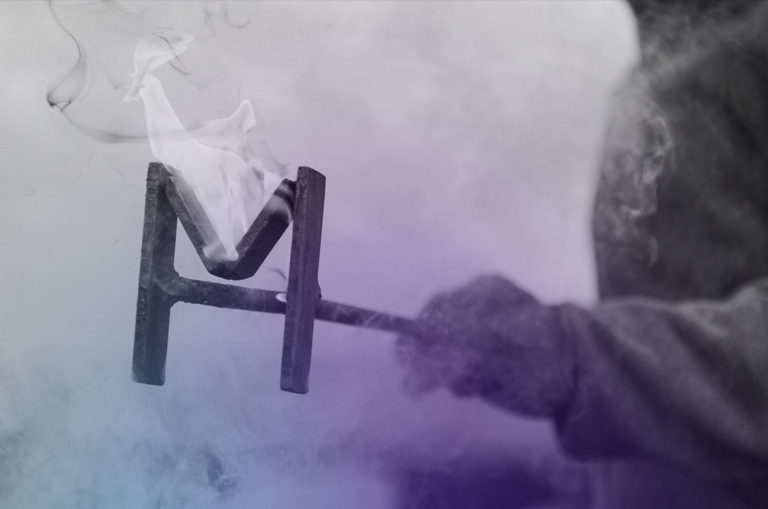Depending on who you are this might sound really basic and easy. What’s the point of trying to talk about the definition of such a well-known term?
I have come to find it fascinating to challenge the basic terms like this one because I always find insight that brings a new level of clarity to the topic.
In this article, I want to explore the meaning of the word branding as a process by which you get a result: the brand. I will share my point of view on how that process looks like. I will also use tattooing as an example to better understand branding. This might give you some ideas on how to create and develop your brand.

We are not on the same page: Different definitions for the same word
Branding is a very popular word these days, but at the same time, not everybody is meaning the exact same idea when they use it.
If you Google it you will get the following results: “the action of marking with a branding iron.” (Not the connotation that we are interested in this case). It also says: “the promotion of a particular product or company by means of advertising and distinctive design.” Is branding really all about promotion?
Let’s keep exploring some other definitions I found. The Branding Journal website says: “Branding is the process of giving a meaning to specific organization, company, products or services by creating and shaping a brand in consumers’ minds.” Is it really about creating meaning? And how do you create this meaning?
One of the best definitions I found is by Kylie Goldstein from Wix, she says: “Branding refers to the deliberate actions you take to influence people’s perception of your product or service — so they will choose your brand time and again.”
With so different definitions of the same word, how could we say that everybody knows what branding is?

Is “brand” and “branding” the same thing?
While looking for more definitions I came across a couple of cases that really called my attention.
The first case is the one from the magazine Entrepreneur, in their website they say: “what exactly does “branding” mean? Simply put, your brand is your promise to your customer.” Are they saying that those terms are the same thing?
Let’s analyze the second case. If you type “what is branding?” on YouTube you will get in the first results a video from The Futur called “What Is Branding? 4 Minute Crash Course.”
In it, Chris Do asks Marty Neumeier: “The term branding people use it interchangeably with logo design, identity design, and even sometimes typography and maybe we need to set the record straight. I know you are the best person to tell us what is branding”
Marty replies: “Yes. So, let’s start with what branding isn’t, cause it is not a lot of things people say it is. It’s not a logo. A logo is a very useful tool for business, but is not the brand, it’s a symbol for the brand. (…) a brand is a result, a customer’s gut feeling about a product, service, or company.”
Also in the description of the video it says: “What is branding? A brand is not a logo. A brand is not a product. A brand is not a promise.”
It is clear how they are using the word branding and brand interchangeably. The question arises again, are they saying that those two terms are the same thing? Is really branding and brand the same concept?
I just asked a Google marking expert that happens to be working beside me in the same co-working space here in Mexico while I’m writing this article, and her answer was yes, she thinks is the same thing.
I’ve concluded that these two words have been used interchangeably just because of how English works sometimes. For example, the word “painting”. Wikipedia defines it as: “the practice of applying paint, pigment, color or other medium to a solid surface” but also says “In art, the term painting describes both the act and the result of the action (the final work is called “a painting”).” However, I don’t think this example can fully justify how these two words (branding and brand) have been used. The word “painting” doesn’t suffer from the ambiguity that the word “branding” does. Most people have a similar idea of what painting is, but as we saw there are different definitions for “branding”. Also, if you check the definition of the “painting” on the Merriam-Webster’s dictionary you see that it has two connotations: “1. a product of painting. 2. the art or occupation of painting”, but if you look for the word “branding” it only has one connotation: “the promoting of a product or service by identifying it with a particular brand”, which is, by the way, another weird definition to add to the list.
In Spanish (my native language) we have a word for “brand”: marca, but interestingly enough we don’t have a translation for “branding”, we use it as it is. That’s why for me it is hard to see them as the same thing.

What is branding?
In the video we just talked about, Marty says: “a brand is a result”. I definitely agree with that. But then if “brand” is the result then the process by which that result is obtained should be what we call “branding”. The brand is the result, branding is the process, as simple as that.
Last year I took a course on branding for startups in a local Costa Rican university, where they introduced me to a video from Andy Stalman, one of the most prominent branding specialists in the Spanish-speaking world. He defines branding as “the process of creation, development, and constructions of brands”. This definition caught my full curiosity. Is branding also about the creation of the brand?
Going back to the definition from Kylie Goldstein, “Branding refers to the deliberate actions you take to influence people’s perception of your product or service…” Is brand strategy part of those deliberate actions? When does the process of branding really start? According to Andy Stalman, it starts at the beginning, with the creation of the brand.

Tattooing: Maybe the best example to understand branding
The origins of branding come from ancient civilizations burning marks into their livestock to identify them as part of their property. This had to be made with fire because it was the most effective way to get a long-lasting effect, otherwise, it could have been easily erased, which would have defeated the purpose. That same long-lasting effect is also what gives tattoos their main peculiarity.
One of the definitions of tattooing is found on the website of the Suede Ink Studio: “Tattooing is one of the oldest art forms known to humans. It is a type of body modification that involves creating permanent letters, symbols, or other images on the skin. Ink is injected under the surface of the skin, by piercing it with a small needle.” Here tattooing is the process, and the tattoo is the result.
The tattooing process doesn’t start with the needles entering the skin. It starts when the client tells the tattoo artist the idea and then they talk about the colors, the techniques, etc. Once the planning phase is done, the design is printed into a stencil and then transferred into the skin. Then all is ready for the needles to start injecting little by little the ink under the skin.
With branding is the same thing. Branding doesn’t start when people form their perception about a product, service, or company. Branding starts with the initial plan.

Andy Stalman says: “everybody does branding, some do it without knowing and some do it intentionally through a strategy. A non-existing or a bad strategy can take you to failure”. If you don’t have a brand strategy it doesn’t mean that people would not have a perception of you or about what you offer. It means that you are losing the opportunity to intentionally influence that perception to your benefit.
If branding starts with planning, where does it end? This is more difficult to establish because you can close your business and stop taking actions to influence your brand, but your brand can be kept alive by the people. That’s why some people say that this is a perpetual process. This is the case with Blockbuster, their brand is kept alive by everyone who, for instance, talks about how they did not anticipate the impact Netflix would have on them.
The 2 phases of the branding process
Now that we have established that branding is a process let me share with you what I believe is how this process looks like.
The branding process has two main phases: Planning and Execution. Let’s take a deeper look at each one of them.
1 – Brand Planning
This can also be called the Creation Phase. It is true that the tattoo only starts to be visible only once the needles start piercing the skin with ink, but if there was no planning before that then the result could be a disaster. The same is true with your brand. You can spontaneously start offering your products or services without any plan whatsoever, but the probabilities of failure will dramatically increase. Instead, planning allows you to decide what is the kind of experience you want people to have with your brand. This is why planning can be considered as one of the most important parts of branding. These are the three most important areas where you need a solid plan:
a. Business model. Will your services be considered premium? What solutions will your clients find in your business? What type of products and services will you sell? Things like these are important elements of the reputation your business will have. It all starts with defining the right business model.
b. Brand strategy. Here is where you can make a plan on how you will influence your brand. Remember that your brand is not what you say it is, is what they say about you. You cannot fully control your brand, because you cannot control what people think about you. But that doesn’t mean that you cannot proactively influence that perception in your favor. That’s the real power of brand strategy.
c. Marketing strategy. Each marketing action will be a touchpoint and represents a valuable opportunity to create the best perception possible from the people you are trying to reach. This is why is so important to make a general plan on how you will present yourself as the best option to solve any given problem.
2 – Brand Execution and Development
Once the tattoo artist and the client have agreed upon how the tattoo should look like, then it’s time for the action. The skin becomes the canvas where each ink injection starts forming the final design. With the brand the canvas is the minds of people, each touchpoint works as those needles being injected. And the ink? The ink is the emotions, is what has the power to stick the longest in the human mind. That’s why Cola-Cola don’t promote their drink, they promote the happiness you experience while sharing special moments (around a Cola-Cola of course). Emotions are the special ingredient branding added as a response to the noise regular advertising was creating. I read somewhere that people remember 1/3 of what they listen to, half of what they read, and 100% of what they feel. Even though I believe those numbers are way off, there is scientifically proven truth to that: people remember more emotions than anything else. In 2017 the National Center for Biotechnology Information published a study called “The Influences of Emotion on Learning and Memory”, there they say: “Substantial evidence has established that emotional events are remembered more clearly, accurately and for longer periods of time than are neutral events.” With this perspective, we can say that branding is the process by which different touchpoints leave an emotional mark on the minds of people. As we can see, the different touchpoints are an essential tool for the formation of the brand. Wikipedia says “A touchpoint can be defined as any way a consumer can interact with a business, whether it be person-to-person, through a website, an app or any form of communication”. Let’s see some types of “needles” that can form your brand:
Before the purchase:
Marketing. To me, marketing is all about presenting your product or service to people as the best option to solve a specific problem. I have seen many places where they say that branding is part of marketing. The problem is that, as we’ll see later, branding is involved in so many more other areas of your business than just marketing. I would say that there are two types of marketing touchpoints:
- Internal: These are the specific actions your business takes (ads, e-mail campaigns, sponsorships, social media content, etc.)
- External: This is the marketing other people do for you. In other words when people recommend you to others as a great option to solve a given problem. This is a really important part to pay attention to since for some businesses 80% of the influx of new clients comes from referrals. Paying attention to each touchpoint is important because you want to influence the perception people will have of you, but it is also important because if you stay memorable and relevant enough people might want to transfer that perception to others at some point.
During the purchase
Sales: What is the perception you want people to have during the sales process? How easy and simple was the buying experience? Here is where important aspects from the brand strategy such as personality, tone of voice, values, etc., should really come into play. Every sales call will leave a perception in the minds of people, especially from how you made them feel.
After the purchase
Delivery: By this point marketing and sales were effective enough to land you a new project, or a new product sold. Branding doesn’t stop here, those needles will keep on forming a perception throughout the whole delivery process. This is true for both products and services.
- Products: Did the customer receive the product on time? Did it meet the expectations you set? Was it easy to use?
- Services: Was the project managed properly? Was there good communication? Was the project completed on time? Did the results meet or exceed your client’s expectations?
Customer Support: Sometimes things don’t go as expected. The product was never delivered, or it is not working, or they received the wrong thing. What kind of support will your customer receive from you in those cases? How will their experience be like? This could also apply to services. What will happen if for some reason you are not able to complete the project on time? What happens if the website crashes for some reason? What if the files you sent won’t open? What kind of support will the client have from your end? This is a major touchpoint because it might be the last impression they have of you. This might define if they will buy again from you and if they will recommend you.
Branding is an ongoing process that we should be aware of at all times. It involves all the areas of your business. Remember that a brand is not what you say but what people say about you, and branding is a set of plans and actions aimed to influence that perception in your favor. Such an important part of your business cannot be left to chance. Make sure you plan for it. Ask yourself, what kind of things do I want people to say about my business? What is my plan to influence that perception? Review continuously each one of your touchpoints and see if they are aligned with your brand strategy.
I really hope that this exploration I’ve made about the word branding has given you some insight that will make you think about how you can improve your branding process so that you can have a brand that you can feel proud of.



